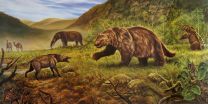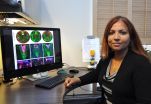(Press-News.org) Turn on any local TV weather forecast and you can get a map of where skies are blue or cloudy. But for scientists trying to figure out how clouds affect the Earth's environment, what's happening inside that shifting cloud cover is critical and hard to see.
To investigate the layers and composition of clouds and tiny airborne particles like dust, smoke and other atmospheric aerosols, , scientists at NASA's Goddard Space Flight Center in Greenbelt, Maryland have developed an instrument called the Cloud-Aerosol Transport System, or CATS. The instrument, which launches to the International Space Station in December 2014, will explore new technologies that could also be used in future satellite missions.
From space, streaks of white clouds can be seen moving across Earth's surface. Other tiny solid and liquid particles called aerosols are also being transported around the atmosphere, but these are largely invisible to our eyes. Aerosols are both natural and man-made, and include windblown desert dust, sea salt, smoke from fires, sulfurous particles from volcanic eruptions, and particles from fossil fuel combustion.
Currently, scientists get a broad picture of clouds and air quality conditions in the atmosphere and generate air quality forecasts by combining satellite, aircraft, and ground-based data with sophisticated computer models. However, most datasets do not provide information about the layered structure of clouds and aerosols.
CATS will provide data about aerosols at different levels of the atmosphere. The data are expected to improve scientists' ability to track different cloud and aerosol types throughout the atmosphere. These datasets will be used to improve strategic and hazard-warning capabilities of events in near real-time, such as tracking plumes from dust storms, volcanic eruptions, and wildfires. The information could also feed into climate models to help understand the effects of clouds and aerosols on Earth's energy balance.
Clouds and aerosols reflect and absorb energy from the sun in a complex way. For example, when the sun's energy reaches the top of the atmosphere, clouds can reflect incoming sunlight, cooling Earth's surface. However, clouds can also absorb heat emitted from Earth and re-radiate it back down, warming the surface. The amount of warming or cooling is heavily dependent on the height, thickness, and structure of clouds in the atmosphere above.
"Clouds are one of the largest uncertainties in predicting climate change," said Matt McGill, principal investigator and payload developer for CATS at Goddard. "For scientists to create more accurate models of Earth's current and future climate, they'll have to include more accurate representations of clouds."
That's where a new instrument like CATS comes in. CATS is a lidar - similar to a radar, but instead of sending out sound, lidars use light. CATS will send a laser pulse through the atmosphere towards a distant object like a cloud droplet or aerosol particle. Once the energy reaches the object, some of the energy is reflected back to the lidar receiver. Scientists can calculate the distance between the instrument and the object, based on the time it takes the energy to return to the receiver, thereby determining the altitudes of cloud and aerosol layers. The intensity of this return pulse also allows scientists to infer other properties, such as the composition of clouds, and the abundance and sizes of aerosols,.
In 2006 NASA launched the Cloud-Aerosol Lidar and Infrared Pathfinder Satellite Observations, or CALIPSO, spacecraft--a joint mission between NASA and France's space agency, the Centre National d'Études Spatiales. CALIPSO carries a lidar that provides vertical distributions and properties of clouds and aerosols along a flight track. However, the CALIPSO lidar has exceeded its three-year prime mission and has been using its backup laser since 2009.
A unique opportunity to continue gathering this type of data presented itself in 2011 when the International Space Station Progam's NASA Research Office offered scientists at Goddard a mounting location aboard the space station for a new lidar instrument - CATS, and provided the funding for its construction.
Designed to operate for at least six months, CATS has a goal of operating for three years. With beams at three wavelengths (1064, 532, and 355 nanometers), CATS will be used to derive a variety of properties of cloud and aerosol layers. These properties include layer height, layer thickness, and at least coarse information on the type of aerosols and cloud in various atmospheric layers.
CATS will orbit aboard the space station, which flies at an altitude between 230 miles (375 kilometers) and 270 miles (435 kilometers) above Earth's surface at a 51-degree inclination. This unique orbit path will allow the CATS instrument to observe locations at different times of day and allow scientists to study day-to-night changes in cloud and aerosol effects from space.
Studying clouds and aerosols won't just help scientists study the climate, it's also a chance to investigate air quality and how atmospheric particles affect daily life. That can range from volcano ash plumes, to dust storms, to pollution outbreaks, to wildfires, like the California Rim Fire in September 2013 that choked Yosemite National Park during the busy Labor Day weekend. These particles pose health risks to populations, especially to the medically vulnerable, By infusing CATS data directly into aerosol models, data from CATS can make a difference in tracking and responding to impacts of similar events in the future.
INFORMATION:
For more information about CATS, visit: http://www.nasa.gov/cats or cats.gsfc.nasa.gov
For more information about the space station, visit: http://www.nasa.gov/station
NASA's Hurricane and Severe Storms Sentinel, or HS3, mission investigated four tropical cyclones in the 2014 Atlantic Ocean hurricane season: Cristobal, Dolly, Edouard and Gonzalo. The storms affected land areas in the Atlantic Ocean Basin and were at different stages during the investigations.
The HS3 mission pilots flew a remotely piloted Global Hawk aircraft over Cristobal, Dolly, and Edouard and flew a manned WB-57 aircraft over Gonzalo. During the flights, Cristobal transitioned from a hurricane into an extra-tropical storm. Edouard strengthened from a tropical storm ...
December 1, 2014 --Years after the end of the Great Recession, child poverty remains widespread in America's largest cities. A paper just released by the National Center for Children in Poverty (NCCP), a research center based at Columbia University's Mailman School of Public Health, reports that nearly three children in five living in Detroit are poor, according to the most recent Census figures. This rate has grown by 10 percentage points since the onset of the Great Recession in 2007.
Most children in Cleveland and Buffalo also live in poverty, as do nearly half ...
West Orange, NJ. December 1, 2014. Kessler Foundation researchers have authored a new article that provides insight into the variable impact of traumatic brain injury (TBI) on long-term memory. The article, "Working memory capacity links cognitive reserve with long-term memory in moderate to severe TBI: a translational approach," was epublished ahead of print on October 7 in the Journal of Neurology (10.1007/s00415-014-7523-4). The authors are Joshua Sandry, PhD, John DeLuca, PhD, and Nancy Chiaravalloti, PhD, of Kessler Foundation. This study was supported by grants ...
WASHINGTON (Dec. 1 2014) -- For patients in cardiac arrest, administering epinephrine helps to restart the heart but may increase the overall likelihood of death or debilitating brain damage, according to a study published today in the Journal of the American College of Cardiology.
The study offers new data in an ongoing debate over the risks and benefits of using epinephrine to treat cardiac arrest, an often-fatal condition in which the heart stops beating. Epinephrine, also known as adrenaline, is a hormone that stimulates the heart and promotes the flow of blood. ...
Give therapists and psychiatrists information about the biology of a mental disorder, and they have less -- not more -- empathy for the patient, a new Yale study shows.
The findings released Dec. 1 in the Proceedings of the National Academy of Sciences, challenge the notion that biological explanations for mental illness boost compassion for the tens of millions of Americans who suffer from mental-health problems.
Conventional wisdom suggests that biological explanations for psychiatric symptoms should reduce the blame patients receive for their behavior by making ...
Existing age estimates of American mastodon fossils indicate that these extinct relatives of elephants lived in the Arctic and Subarctic when the area was covered by ice caps--a chronology that is at odds with what scientists know about the massive animals' preferred habitat: forests and wetlands abundant with leafy food. In a paper published this week in the Proceedings of the National Academy of Sciences, an international team of researchers is revising fossil age estimates based on new radiocarbon dates and suggesting that the Arctic and Subarctic were only temporary ...
RIVERSIDE, Calif. - Multiple sclerosis (MS), an autoimmune disease of the brain and spinal cord, affects about 2.3 million people worldwide (400,000 in the United States). Affecting more women than men, it can be seen at any age, although it is most commonly diagnosed between the ages of 20 and 40.
An unpredictable disease that disrupts the flow of information within the brain and between the brain and the body, MS is triggered when the immune system attacks the myelin sheath, the protective covering around the axons of nerve fibers. The "demyelination" that follows ...
CHAMPAIGN, Ill. -- The house mouse, stickleback fish and honey bee appear to have little in common, but at the genetic level these creatures respond in strikingly similar ways to danger, researchers report. When any of these animals confronts an intruder, the researchers found, many of the same genes and brain gene networks gear up or down in response.
This discovery, reported in the Proceedings of the National Academy of Sciences, suggests that distantly related organisms share some key genetic mechanisms that help them respond to threats, said University of Illinois ...
The rapid evolution of HIV, which has allowed the virus to develop resistance to patients' natural immunity, is at the same time slowing the virus's ability to cause AIDS, according to new research funded by the Wellcome Trust.
The study also indicates that people infected by HIV are likely to progress to AIDS more slowly - in other words the virus becomes less 'virulent' - because of widespread access to antiretroviral therapy (ART).
Both processes make an important contribution to the overall goal of the control and eradication of the HIV epidemic. In 2013, there ...
The most commonly used medications for osteoporosis worldwide, bisphosphonates, may also prevent certain kinds of lung, breast and colon cancers, according to two studies led by researchers at the Icahn School of Medicine at Mount Sinai and published today in the Proceedings of the National Academy of Sciences (PNAS).
Bisphosphonates had been associated by past studies with slowed tumor growth in some patients but not others, and the mechanism behind these patterns was unknown. In the studies published today, an international research team showed that bisphosphonates ...





